Amaro A., Reed D., Soares P. (editors) Modelling Forest Systems
Подождите немного. Документ загружается.


33Amaro Forests - Chap 29 25/7/03 11:09 am Page 346
346 J.J. Colbert et al.
Vanclay, J.K. (1994) Modelling For
est Growth and Yield. CAB International, Wallingford, UK, pp.
380.
von Bertalanffy, L. (1957) Quantitative laws in metabolism and growth. Quarterly Review of
Biology 32, 218–231.

34Amaro Forests - Chap 30 1/8/03 11:54 am Page 347
30 Landscape Visualization with
Three Different Forest Growth
Simulators
Falk-Juri Knauft
1
Abstract
Individual-based tree models are well suited to represent growth processes at scales where trees
interact through mutual shading and/or root competition. Management decisions in general are
performed at larger scales even when selective thinning is considered. Unfortunately, no satis-
factory scaling theory is available to upscale from the individual tree to the stand or even land-
scape level, but modern information technology provides several options to attempt
‘brute-force-solutions’ that circumvent the scaling problem, i.e. modelling a sufficient number of
individual trees in a stand/landscape (depending on the application) to represent the spatial
distributions of properties of simulated forests with meaningful precision. This chapter will pre-
sent three different integrated systems/examples to approach this (scaling) task at various lev-
els of detail and realism. In all three examples the simulator kernel is individual tree-based; it is
linked to GIS functionality and a visualization interface. They differ in their purposes and hence
in number/detail of processes included and the resolution of the visualization interface. The
first example, VIWA, integrates the tree-growth model SILVA with the tree visualization package
AMAP. Its main purpose is to serve as a communication interface between forest managers and
the public, requiring an almost photo-realistic visualization. The second example, VIWA2, is
aimed at forestry experts only and thus allows a more abstract presentation of trees. It combines
the forestry-oriented simulator BWIN with a landscape visualization tool ENVISION. The third
example is targeted at the communication between forest experts and ecosystem researchers. It
combines TRAGIC++ with the AMAP package and has an interactive user interface JTRAGIC.
Introduction
Communication about such complex problems as the goal-oriented management of
forest stands and landscapes is, especially in the case of discussion partners with
different backgrounds, a very difficult task. Without appropriate visualization tools,
the subjective perceptions will be strongly diverse. To clarify and (potentially) solve
this problem we suggest focusing on an interactive simulation and visualization
environment.
1
Bayreuth Institute for Terrestrial Ecosystem Research, Germany
Correspondence to: falk-juri.knauft@bitoek.uni-bayreuth.de
© CAB International 2003. Modelling Forest Systems (eds A. Amaro, D. Reed and P. Soares) 347

34Amaro Forests - Chap 30 1/8/03 11:54 am Page 348
348 F.-J. Knauft
A simulation is a software-based implementation of models and therefore a
simplified representation of real world aspects. Common applications of computer-
ized simulation in forestry can be found in the field of growth modelling. A number
of different approaches can be identified. Practical forestry-related groups of model
developers prefer empirical or holistic models, while groups oriented more towards
ecosystem research prefer process models.
The visualization of simulated or empirical data is a traditional method for
analysis but also for pr
esentation (e.g. of predicted scenarios). Because of the supe-
rior human ability to identify/recognize complex patterns, it is an effective interface
for the transfer of complex information. As the predominant traditional visualiza-
tion technology in forestry, the spatial context of many pieces of information (data)
led to a wide utilization of maps.
Interaction in the context of forest simulation has so far been realized inside the
model as interaction among individual tr
ees, and outside the model as interaction
between the simulator and its user. In the context of this chapter we include the inter-
action between people, who might be, for instance, different users of the simulation
tool.
The task of transferring information is supported by communication tools
(media). Maps of for
est units are one traditional example of documenting the con-
text for silvicultural decisions. Table 30.1 shows a selection of traditional communi-
cation tools in forestry and related sciences. They can be differentiated by their
partners, the type of possible interaction among them, and the corresponding tem-
poral and spatial scales.
State of the Art
The recent development in information technology has had an enormous impact on
this research-relevant technology. One of the biggest benefits can be found in the
field of simulation technologies. Just a few years ago, detailed simulation of individ-
ual-based tree growth was a difficult and, in regard to computation capacity, expen-
sive task. Today, a number of different simulation tools can run on nearly every
modern PC. For the German region the most common are
BWIN (Nagel, 1997) and
SILVA (Kahn and Pretzsch, 1997; for a technical comparison see Windhager, 1999).
Both were initially developed from empirical models, but later supplemented by
Table 30.1. Traditional communication tools between foresters (F), scientists (S) and the public (P) (t →
point in time, t+dt → later point in time, ×→position, x+dx → different position) (the entry ‘no way’ marks
communication channels that face technical difficulties for the given task).
Communication tool Partner Space Time Direction
Forest maps F(t) → F(t+dt) Stand (ha) 10–20 years One way
F(t) → P(t)
Administrative records F (t) → F (t+dt) Stand (ha) 160 years One way
Joint visits to forest F(x) → F (x+dx) Group of trees Hours–days Interactive
Silvicultural books F (t) → F (t+dt) Variable Personal No way (?)
F(x) → F (x+dx) memory
Publications S(x) → S (x+dx) Variable Often < years One way
Political programmes, visions, goals P→ all Variable Variable Interactive ?
Predictions S(t) → all (t+dt) Variable Variable One way, No
way(?)

34Amaro Forests - Chap 30 1/8/03 11:54 am Page 349
349 Landscape Visualization with Forest Growth Simulators
process models. The opposite development can be seen for the growth simulator
TRAGIC++ (Hauhs et al., 1993, 1995, 1999; BITOEK, 2002a).
Forestry-related individual-tree-based growth models, such as
BWIN and SILVA,
differentiate the individual tree into only a few compartments, such as root, stem
and crown. Functional–structural growth models identify a much larger number of
compartments. They model specific functionalities for the compartments, and the
result of the simulation typically depends on the generated structure within the
individual tree. One approach of this type uses so-called L-systems (Lindenmayer,
1968). The idea of a rule-based behaviour of tree growth has been implemented in
the ‘growth engines’ of
GROGRA (Kurth, 1994, 1999) and AMAP (de Reffye and Blaise,
1993).
Parallel to the development of sophisticated growth simulators, visualization
technologies also advanced to new levels. T
raditional media such as graphs and
maps can now be generated with a few mouse clicks. The production of maps,
especially, gained much greater efficiency with the introduction of geographical
information systems (GIS). These systems even enable the user to create 3D maps
with very little effort. One step further is the creation of 3D scenes based on tech-
nology standards such as
VRML, OPENGL and DIRECTX (see Seifert, 1998). These are
used at different levels of resolution and quality as visualization tools in all of the
mentioned growth simulators. Most of the difference is caused by the high
demand of computation capacities for these visualization technologies, and their
varying availability.
The generation and processing of large quantities of data has become common
thr
ough use of the described technologies along with effective tools for data storage
and transfer. The spatial context of forestry-related data calls for GIS functionalities.
To transfer data of complex and variable structure among independent modules of
different standards, tools such as XML have been developed. The eXtensible
Markup Language is a mechanism to identify structures (content such as words, pic-
tures, etc. and some indication of what role that content plays) in a document
(ASCII file, stream, etc.).
Besides the exchange of information among the software packages, one major
task is the appr
opriate transfer to the user. For the realization of communication and
interactivity between the user and the software, the graphical user interface (GUI)
became the standard with the introduction of the Apple Macintosh. Today, conve-
nient developer kits enable the engineering of adapted GUIs.
Methodology
The three modules concept
As the general structure of our forestry-related information system we concentrate
on thr
ee main components: simulator, database and visualization tools (Knauft,
2000). This structure has been realized to various degrees of integration in profes-
sional forest information systems (
ABIES, FOGIS–INTEND Kassel), as well as in academic
systems (
VIWA, TRAGIC, FORCITE).
The availability of efficient tools such as GIS, forest growth simulators and tree
or landscape visualization tools, combined with limited financial r
esources, favours
a modular concept. Table 30.2 presents an overview of the criteria which have
influenced the selection in the presented applications.

34Amaro Forests - Chap 30 1/8/03 11:54 am Page 350
350 F.-J. Knauft
Table 30.2. Case-specific criteria for software selection.
Partner Case-specific selection criteria Selected software
Forester/general public All components already available, SILVA – ARCINFO – AMAP
high claims on realistic visualization
Forester/forester BWIN and ARCINFO already available, BWIN – ARCINFO – ENVISION
visualization software as freeware
Forester/ TRAGIC and ARCINFO already available, TRAGIC – ARCINFO – AMAP
scientific community high claims on detailed visualization
A first design concept – VIWA
Our first idea to develop an integrated forest simulation and visualization system
grew from the demand for a tool to support forestry management decisions by illus-
trating their impact on the forest landscape over a time scale of decades (Knauft,
2000; Knauft and Sloboda, 2000). The task defines the participants in the communi-
cation problem: foresters and the general public. It demands a reliable simulation of
forest growth and management up to a full rotation cycle, a flexible and powerful
spatial database for the processing of stand and individual tree data and, finally, an
almost photo-realistic visualization of the scenery including botanically correct
three-dimensional forest tree models (in contrast to ‘billboard-icons’ as used in
ENVI-
SION (McGaughey, 2000)). The solution was found in an integration of the forest
growth simulator
SILVA, the GIS ARCINFO, and the tree architecture visualization
toolkit
AMAP.
The data processing starts in the GIS with sets of stand data and related geo-
graphical entities.
A region can be selected using a map interface. The stand data (f.i.
inventory data) of the selected region are transferred to the simulation tool, which
generates samples of the initial individual tree structure of the stands. With these
structure samples, the full stand structure is created inside the borders of the stand
unit and stored in the GIS. Based on these samples, additional growth and manage-
ment intervals can be simulated. These can be used in turn to create scenarios of for-
est landscape development. The final step is the transfer of the individual tree data
and the digital elevation model to the visualization tool, where single images, time
series or movements through the scene in image series or animations can be ren-
dered and recorded. The implemented system
VIWA (short for ‘Virtueller Wald’ - vir-
tual forest) is costly and complicated, due to the use of commercial software
(
ARCINFO and AMAP) on three different computers with different operating systems.
The second example –
VIWA 2
These resources were not affordable for a second application. The Forest Research
Station of Lower Saxony asked for a system to support communication within the
for
estry community which should be efficient to use. Therefore, we chose, as well as
the already licensed GIS
ARCINFO, the simulator BWIN (developed at the research sta-
tion) and the visualization tool
ENVISION (McGaughey, 2000). For efficient use, all
these products can be run on a single computer (operating system MS Windows-NT
and upwards) and can be accessed over a GUI, which also controls the interfaces
between the software components (see Fig. 30.1). The data handling of this system is
generally the same as in the first system, but via the GUI it is much easier to handle
and to control.
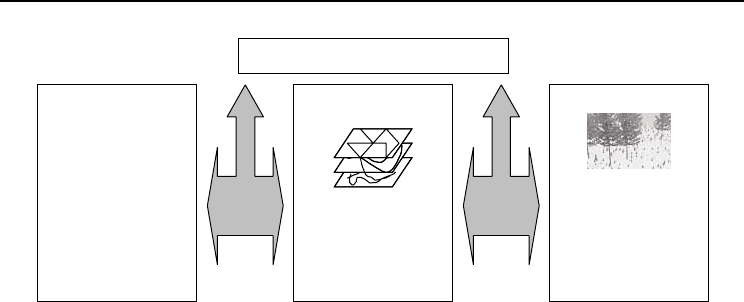
34Amaro Forests - Chap 30 1/8/03 11:54 am Page 351
351 Landscape Visualization with Forest Growth Simulators
Graphical user interface
BWINPRO
Silviculture,
growth,
mortality
ARCINFO
tree data,
stand data,
objects
ENVISION
Images,
animation of
movements
and processes
Topography,
Simulation Database Visualization
Fig. 30.1. Sc
hema of the solution for intra-forestry communication, VIWA 2.
The TRAGIC concept
Finally, at the Bayreuth Institute for Terrestrial Ecosystem Research (BITÖK) we are
developing a communication interface between ecosystem scientists and practical
experts in silvicultur
e. The interface for this specific case places much greater
requirements on the system than the previous applications. Scientists hope to
receive feedback about the quality of their models and the foresters look for a tool
that enables them to document, communicate and plan their management activities
more efficiently. Hence information is required to flow in both directions and the
visualization tool becomes an input interface for the expert forester.
Waiving practical experience as an input and feedback to theoretical research
would be a gr
eat loss. On the opposite side, theoretical research could be interro-
gated as to whether its results would have an impact on practical forestry (see
Schanz, 1994). Therefore, we chose a highly realistic three-dimensional and interac-
tive visualization allowing interactive movements in the virtual scene and interac-
tive action such as the selection of trees for thinning. The system consists so far of
the individual-based forest growth simulator
TRAGIC++, the Internet-accessible visu-
alization front-end
JTRAGIC (Hauhs et al., 1995, 1999; Scheerer, 2000; BITOEK, 2002b)
and a database. The integration of a GIS (here also
ARCINFO) will enable the visual-
ization of landscapes and therefore allow the discussion about forest management at
this scale. The generation and simulation of the data will be realized in the same
way as in the first two applications.
The demand for interactive access to tree and stand data and for simulated
movement thr
ough the stand does (under the constraint of the limited graphics
capabilities of the sort of computers that are typically available in forestry offices)
limit the possible detail level in the visualization. For special situations with higher
expectations, the
AMAP toolkit will be integrated at the server site to generate photo-
realistic still images and recorded animations. So far the transfer of all simulated
structural information (
TRAGIC++ even simulates branches and needles) into the vir-
tual
AMAP scene is not finished, but when completed it will enhance the discussion
between scientists and foresters.
The architecture of the
TRAGIC environment is illustrated in Fig. 30.2. While the
data-server operates the spatial database (tree and stand data) as well as a knowl-
edge repository (silvicultural activities), the simulation-server runs the
TRAGIC server
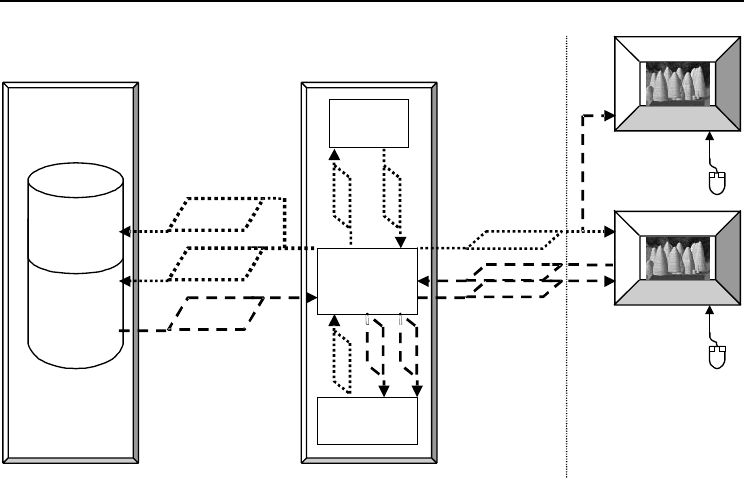
34Amaro Forests - Chap 30 1/8/03 11:54 am Page 352
352 F.-J. Knauft
TRAGIC
server
TRAGIC
++
AMAP
User 1
Database server
GIS
Knowledge
repository
Simulations server
Client PCs
JTRAGIC
User 2
JTRAGIC
Actions
Stand
Stand
Actions
Stand
Stand
StandStand
Stand
Actions
Image
Fig. 30.2. Schema of the fully developed TRAGIC environment as server–client design with interactive user
interface (dashed line, data before simulation; dotted line, data after simulation).
(central data interface), the simulator TRAGIC++ and the visualization tool AMAP. On
the client side, the user can download an older stand, plan its activities, and send
these back to the server, eventually with an additional call for an
AMAP visualization.
After the simulation, the stand data (as individual tree data) are stored in the data-
base along with the related activities. The resulting stand can then be downloaded
from the original user or any other user with appropriate permission.
Data sources
The following applications are based on data from three different regions in Lower
Saxony
.
For the case of communication with the public, we chose stand data from the
exhibition gr
ound ‘ErlebnisWald’ (‘Experience Forest’) near the town of Uslar. We
included the stand parameters of species, basal area, upper height, stand age and
regeneration type (planting or natural regeneration) in the generation of individual
tree data samples by
SILVA. Those were, as mentioned before, multiplied in the GIS
for the full stand area and stored together with a digital elevation model. For the
simulation of management and growth, the samples were again imported and
processed within
SILVA. Only tree position, individual height and species parameters
were transferred to the visualization tool.
The application for the forestry internal discussion illustrates a plot from the
Luenebur
g Heathland. For this case we were supplied with a full tree data table.
Besides position, tree height and species as well as the DBH and lower crown height
were utilized for the visualization. The last example is based on a variety of stand
and management information about the Lange Bramke catchments in the northern
parts of the Harz mountains (see also Hauhs, Chapter 5, this volume).
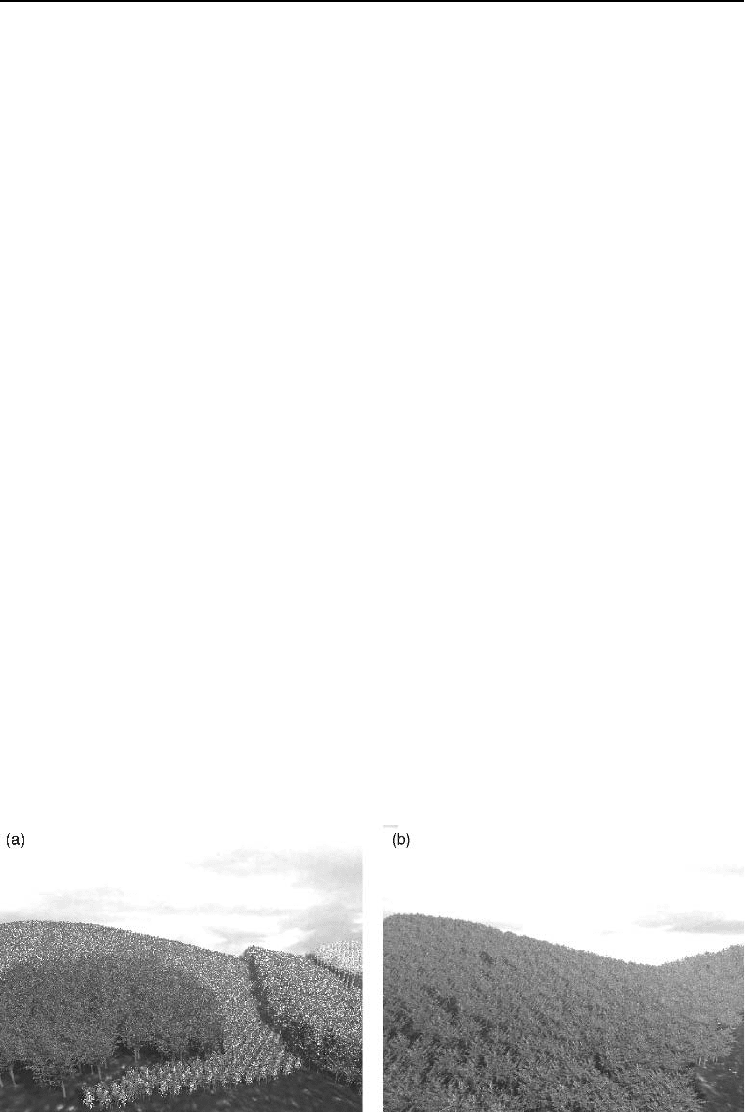
34Amaro Forests - Chap 30 1/8/03 11:54 am Page 353
353 Landscape Visualization with Forest Growth Simulators
Results
The VIWA example
The first scenario (Fig. 30.3) presents a possible discussion about the impact of
changes in the for
est management objectives from an intensively managed forest to
a more extensive use with a ‘reconstruction’ of a potentially natural forest type, as is
often demanded by environmental interest groups. To support the relatively abstract
discussion, we generated a virtual scene of a specific forest landscape.
Especially for untrained persons, a photo-realistic visualization is suitable, as it
corr
esponds best with their experience. Additionally, public expectations of virtual
scenes are highly influenced by the quality of television and film productions.
Therefore, highly detailed and botanically correct trees are demanded. Only very
few, mostly professional, rendering systems (such as
AMAP) are able to produce this
quality. They are quite demanding in terms of computational resources. Important
in the context of this chapter is the aggregation of stand structure information into a
landscape view. Less weight is given to a high degree of detail and realism, which
was not demanded for this situation (see also Knauft, 2000).
The
VIWA 2 example
The second case focused on supporting discussions of real or potential situations of
for
est development within the community of foresters and people of similar back-
ground. This group is relatively homogeneous with respect to their knowledge
about structure, growth and management of forests; they share a common expertise.
On the other hand, the communication must be effective and precise. The main top-
ics of their discussion are structure, growth rate and yield, but also stability and eco-
logical value.
In this case, silvicultural research results are presented to a professional audi-
ence. T
o illustrate the method and for better understanding of the situation, the
sampled areas are visualized using the more abstract tree models of
ENVISION (see
Fig. 30.4). Although the visualization seems to be more schematic, it contains
Fig. 30.3. Comparison of visualizations of a forest landscape under recent stand-wise forest management (a)
with the potential historical forest type (b). Both graphics generated with AMAP, reproduction from Knauft
(2000).
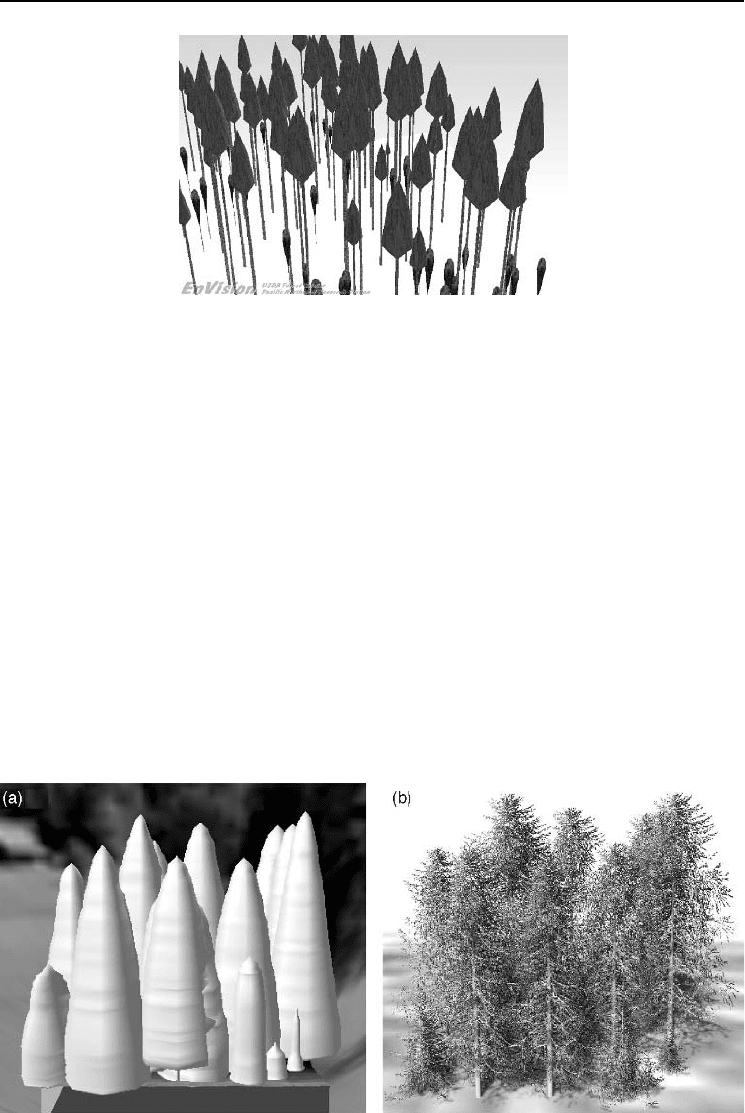
34Amaro Forests - Chap 30 1/8/03 11:54 am Page 354
354 F.-J. Knauft
Fig. 30.4. Visualization of a monitoring plot (graphic generated with ENVISION).
more verifiable information. While in the first application only the generated
parameters of position, species and tree height were used for the visualization, in
this second example, DBH and lower crown height were also taken into account
for the visualization, and all data were actually measured for every individual
tree.
The
TRAGIC example
A combination of the visual realism as implied by the first
VIWA system and the data
representation in the second version can be realized within the
TRAGIC environment.
It consists of the simulator
TRAGIC++, which includes a tabular interface and also a
visualization tool (Fig. 30.5a) and the visual interface
JTRAGIC. The latter does not
include its own simulation module; it is only able to visualize a stand as transferred
from a central database and record the silvicultural activities (movements or silvi-
cultural decisions such as cutting or planting of trees) of the forester. These are sent
back to the simulator and used there for the next simulation period. The example
presented here is part of the restoration of historic stand development (for more
Fig. 30.5. Visualization of a historical plot showing the situation in 1752 as part of a reconstruction from
the 18th century with TRAGIC (a) (see Hauhs, Chapter 5, this volume) and after its export to AMAP (b). The
position and size of stems and crowns are the same in both scenes.
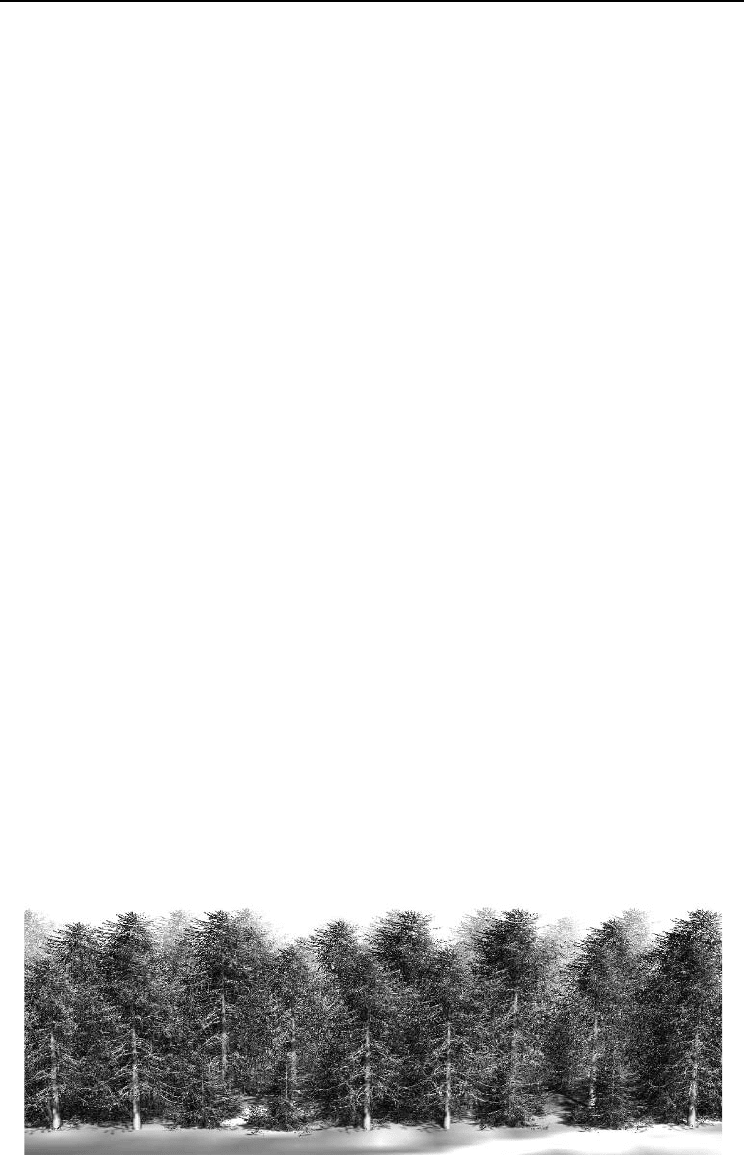
34Amaro Forests - Chap 30 1/8/03 11:54 am Page 355
355 Landscape Visualization with Forest Growth Simulators
details please refer to Hauhs, Chapter 5, this volume). Some indication parameters
are used to evaluate the simulated stands and their structure by the researcher, but
also by foresters. A number of foresters who have been interviewed demanded an
increase in the visual realism of the trees (Schanz, 1994). We included an interface to
the
AMAP toolkit (Fig. 30.5b). For a full stand impression, the plot can than be multi-
plied in the scene (Fig. 30.6).
Discussion and Conclusions
The characteristics of the communication partners
For the field of forest modelling we can identify three major interest groups.
1. The general public possesses little knowledge about the complex processes of for-
est ecosystems. The public is primarily inter
ested in changes at the landscape scale,
as they are interested in the aesthetics and recreational value of forest landscapes,
rather than in individual plant dynamics. Their preferences become settled in poli-
tics, media and economy.
2. Experienced foresters have an inside view about processes which influence the
dynamics of for
ests, but they are also more interested in the (economic) result on
enterprise (or landscape) level rather than individual trees. Based on practical expe-
rience, they have the competence to achieve their goals for specific situations.
3. Less homogeneous are the ecosystem-related scientists, as they focus on individ-
ual or
ganisms, populations or ecosystems. Their competence is based on theories,
experiments and observations, often at the process level.
These three partners are already engaged in several communication processes,
but most of these traditional channels ar
e technically characterized as ‘one-way’ (see
Table 30.1). If interactive communication occurs at all, then it is usually only within
the individual groups. Here the question is whether this is a technical constraint
(there being no proper interactive communication tool), a social constraint and/or
whether it is due to the organization for the tasks at hand?
In the schematic summary of established communication tools in Table 30.1, the
link between r
esearch and management is not covered (see also Schanz, 1994). It is
argued in another chapter (Hauhs, Chapter 5, this volume) that the reason for this
gap is that the relationship between empirical/heuristic models of management and
Fig. 30.6. Visualization of a full stand based on the historical plot reconstruction from the 18th century.
